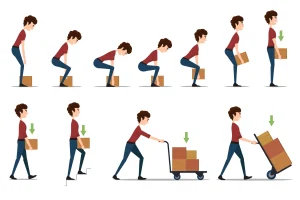What is Manual Handling?
Manual handling refers to the process of lifting, carrying, pushing, or pulling objects by hand. This can include a wide range of tasks, from carrying boxes and packages to lifting heavy equipment or materials.
Manual handling tasks can pose a risk to workers’ health and safety if they are not carried out properly. Incorrect manual handling can lead to musculoskeletal disorders, such as back pain, strains, sprains, and other injuries.

What are risks of Manual Handling?
Some risks of manual handling include:
- Back injuries: Lifting and carrying heavy loads can put a significant strain on the back, which can lead to back pain, strains, and sprains.
- Musculoskeletal disorders: Repeated or prolonged manual handling can increase the risk of developing musculoskeletal disorders, such as tendonitis, carpal tunnel syndrome, and other injuries to the muscles, tendons, and nerves.
- Slips, trips, and falls: Carrying heavy loads can reduce a worker’s balance and increase the risk of slips, trips, and falls.
- Struck by or struck against injuries: Moving heavy loads can increase the risk of being struck by the load or striking against other objects, which can result in injuries such as bruises, cuts, or fractures.
- Fatigue: Manual handling tasks can be physically demanding and can lead to fatigue, which can increase the risk of errors and accidents.
- Psychological stress: Manual handling tasks can also cause psychological stress due to physical demands and the fear of injury.
What is the LITE model of Manual Handling?
Considering these four elements of the LITE model, employers can assess the risks of manual handling tasks and take steps to reduce those risks, such as providing training, using mechanical aids, or redesigning the task to minimize the need for manual handling.
Here’s a brief explanation of each of the elements of the LITE model:
- Load: This refers to the object or load being lifted or moved. Factors to consider include the weight, shape, size, and stability of the load. The load should be assessed to determine whether it can be lifted safely and whether mechanical aids are necessary.
- Individual: This refers to the worker who will be performing the manual handling task. Factors to consider include the worker’s physical capabilities, such as their strength, flexibility, and endurance, as well as their training and experience with manual handling.
- Task: This refers to the specific manual handling task that needs to be performed. Factors to consider include the frequency and duration of the task, the height and distance of the lift, and the presence of any other hazards that may increase the risk of injury.
- Environment: This refers to the physical environment in which the manual handling task will be performed. Factors to consider include the space available for the task, the lighting conditions, the temperature and humidity, and the presence of any hazards or obstacles that may increase the risk of injury.
The 6 safe lifting techniques include:
- Stop and think
- Position the feet
- Bend the knees
- Get a firm grip, keeping the back slightly flexed.
- Raise with the legs
- Keep the load close to the body.